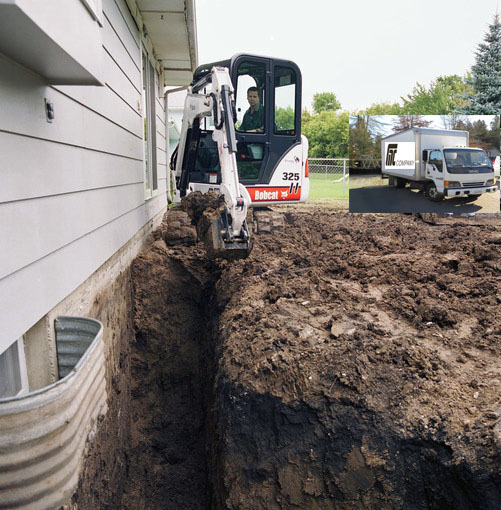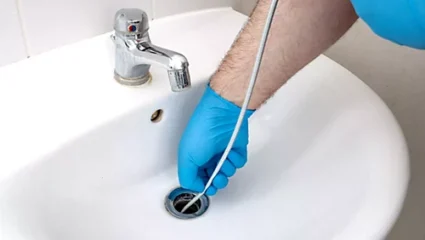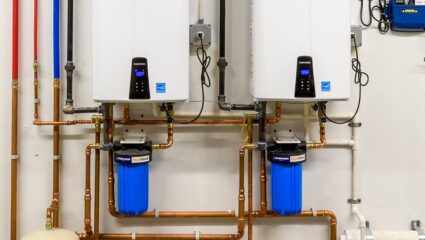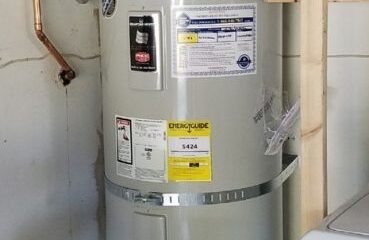Basic Plumbing Wisdom

In the US, plumbing leaks waste 1 trillion gallons of water annually. That’s equivalent to 40 million swimming pools. Most of these leaks don’t even need the attention of a professional.
Armed with a wrench and a few plumbing basics, you can fix some of the most persistent leak problems. Fixing leaks yourself is obviously economical, but you also need to know when to call GAC Company plumbers.
In this article, we’ll dissect the complex mesh of pipes to its most basic. You’ll learn when to go DIY, when to call GAC Company, and how to differentiate the two.
How Does Plumbing Work: Plumbing Basics
Home plumbing is pretty straightforward. A casual gaze at the interwoven mesh of pipes and valves may seem overwhelming but bear with me. Understanding a few plumbing basics will see you navigate the mesh like a pro.
House plumbing consists of two systems:
- Water supply system
- Drain-water system
House Plumbing Basics: Water Supply System
Water supply is a system of pipes that brings fresh water into the home. The system is highly-dependent of pressure. Water in these pipes come from one of two sources:
- City water
- Wells
City water enters your house from a Plastic or Iron pipe ‘the mainline pipe’ that’s usually parallel to your street. If your connection to the main has a problem, call a professional. Damage to the main can result in civil lawsuits and hefty fines.
People who don’t have access to city water usually get their fresh water supply from wells. Water must then be pumped into the home at high pressures. Reduced pressure keeps water from reaching the furthest and highest parts of your house.
Running showers and faucets are usually the first victims of low pressure. Factors affecting pressure range from leaks to blockages. If the leak is caused by a loose connection, it’s easily handled in-house.
If, on the other hand, the leak necessitates re-piping, you best call for a professional plumber.
The main pipe is connected to your water meter. There’s a shutoff valve before or after your meter. The valve cuts off the water supply system making it useful when doing repairs.
Let’s look at the common problems facing the water supply system.
Basic Plumbing Tips: Maintaining the Water Supply System
Correctly installed piping is leak-proof. The system, however, disintegrates with time. In some cases, a plumber may find it necessary to do a complete overhaul of the plumbing.
The water supply system performs optimally when pressure is high. This makes the system rather sensitive to damage.
To illustrate, a leak in the drainage system will only cause damp-related problems. By contrast, leaks in the water supply system take things a step further: They affect water pressure. Low pressure makes it impossible to run showers and flush toilets.
Evidently, leaks are most harmful in the water supply system. Due to the sensitivity of the system, its problems are best handled by professionals.
Plumbing Basics: Drain Water Vent (DWV) System
The two home plumbing systems don’t overlap and for good reason. However, there are bridges all over the home where the two systems meet. Plumbers call these bridges fixtures.
You, on the other hand, know them by their household names: Sinks, faucets, washing machines, and the like.
A fixture is, therefore, defined as any point of water use. Clean water enters a fixture, wastewater leaves. The drainage system relies heavily on gravity to rid the home of wastewater.
The DWV has three main components:
- Drain pipes
- Drain traps
- Drain vents
Plumbing Basics: Components of the Drain Water Vent System
Drain Pipes
These are downward angled pipes that rely on gravity to move water from the fixture and into the sewer line. By observation, you’ll tell this system is more complex than the water supply system: Reliance on gravity has its downsides.
Drain pipes have to be engineered and placed in a manner that lets them play gravity to their advantage. To illustrate, consider the angle of the pipes. These pipes are also bigger than water supply system pipes.
Their size allows them to carry waste without blocking.
Drain Traps
Drain traps, also called P traps, are U-shaped pipes that prevent odors in a plumbing system. These pipes also hold water consistently, thanks to their curvature.
Why should a drain pipe hold water?
The DWV system connects your house to the sewer line. Without the drain trap, sewer gases would turn your house into a stink-fest. Drain traps also allow grease, hair, and other debris to sediment.
This debris is then removed through clean out plugs. Without the traps, the debris would move down the pipe and cause clogging.
Drain Vent
If you turn a bottle of water upside down, water flow is rather hectic. That’s what happens when water flows through a closed system; it’s just not smooth. That’s where drain vents come in.
The drain vent system runs from your roof and into your drain pipe. It releases air into the plumbing to ensure smooth drainage.
Damage to any of these three systems will be reflected in the overall efficiency of the DWV system. Sub-standard products also affect your drainage’s efficacy.
Basic Plumbing Tips: Maintaining the DWV System
Clogging is the biggest problem associated with DWV water systems. Hair is the most common cause of clogging in the bathroom, but grease takes it in the kitchen. To mitigate the risks of clogging, frequently empty clean out plugs.
You must also be on the lookout for leaks. The DWV’s piping is hidden, for the best part. Tell-tale signs of leaks include mold infestations, damp ceilings, and stinky rooms.
Leaks also cause structural damage. It doesn’t hurt to call a professional plumber to look through your piping system for leaks. Just because you don’t see it doesn’t mean it isn’t there: 10% of US homes lose 90 gallons to leaks every day.
Home Plumbing Systems
Plumbing in the home is focused around two areas:
- The kitchen
- The bathroom
Let’s take a closer look at these two systems:
The Kitchen Plumbing System
The kitchen’s plumbing is largely hidden in the walls. The water supply system brings both hot and cold water to fixtures. Plumbing in the walls is another task best left to the plumbers.
The Bathroom Plumbing System
Bathrooms are heavily reliant on pressure. This system also has separate hot and cold piping systems. If pressure ever reduces to a point of concern, Give GAC Company a call.
To reduce pressure by that degree, the leak has to be quite extensive. A DIY approach isn’t the best for such extensive problems. You’ll only make the problem worse.
Basic Plumbing Tips
Now that you’re armed with a few plumbing basics, how do you put them into use?
Let’s look at maintenance. What should you do to prevent expensive plumbing issues? Below are 10 actionable tips:
Unclog Slow Drains
Clogging is a slow process. When you notice water draining slowly, it’s time to take some preventative steps:
- Unclog the pipes. A mixture of vinegar, baking powder, and hot water usually does it.
- Empty the clean out plugs where applicable.
- Call a professional if the problem persists.
Read also how to fix common plumbing problems.
Check the Pipes
Always inspect exposed pipes for signs of wear and tear. Check for leaks where possible and signs of leaking where pipes are hidden. Below are a few signs of leaky pipes:
- Exceptionally high water bills. The average US family uses 400 gallons daily
- Mold and damp
- An ever-running meter
Drain the Water Heater
Empty water heaters at least twice every year. Sediment reduces the efficiency of the heater and may cause complications down the road. If the heater already shows signs of damage, call a GAC Plumbing Company.
Most plumbers spend about 2000 hours in apprenticeship. Even the greenest plumber is better-equipped than you to handle that heater.
Winter Wisdom
Always insulate your pipes in the winter. Most people know this, but you’d be surprised to realize just how many people fall victim to frozen pipes every year. That’s not even the worst-case scenario.
Water expands as it freezes. Therefore, insulation keeps your pipes from exploding.
Strainers
Strainers will save your pipes from clogging. They keep debris from entering the plumbing, saving you hefty plumbing fees. However, strainers are also susceptible to wear and tear.
Replace them as often as necessary. That simple tool is probably the only thing standing between you and a clogged sink.
Enzyme-Based Pipe Cleaners
There’re many pipe cleaning solutions in the market, but not all are equal. Corrosive pipe cleaners do more harm than good. They quickly remove the clog, but at the expense of the piping’s longevity.
This is why you should always go for enzyme-based pipe cleaners. These natural cleaners introduce bacteria into the plumbing. The bacteria break down clog into liquid for easy expulsion.
Bacteria does all that without harming the plumbing’s structural integrity.
Water Pressure
Reduced water pressure is a precursor to plumbing problems. Always call in a plumber when pressure runs low. The quick reaction may save you from incurring hefty repair fees in the future.
In the showers, reduced pressure may be caused by sediment in the shower head. Be sure to clean out shower heads before calling a plumber.
Pro Tip: When leaks are serious enough to reduce your home’s water pressure, they’re best left to a professional. You’re probably looking at a problem that’ll necessitate pipe replacements.
Sewer Lines
Take time to understand how your sewer line is set up. Avoid planting trees along the line because the roots can cause damage. To keep things smooth, periodically snake the lines.
Leave all other sewer problems to the professionals. Damage to shared parts could clog your neighbors’ plumbing which is a sure way to attract civil lawsuits.
Watch What You Flush
keep debris from the drains and you’ll keep clogs from the plumbing. Teach the kids how to maintain the plumbing. Arming them with a few plumbing basics may just save the plumbing from them.
Clogs take time to grow into proportions of concern. Therefore, most people are unaware that the clogs of today are caused by yesterday’s mistakes. Don’t be one of them. Watch what goes down your drains.
Regular Maintenance Run
Calling in the plumbers when there’s a problem is calling in the plumbers too late. Schedule maintenance runs where a plumber inspects the state of your plumbing. Another trick is to ask for suggestions from a professional when buying plumbing equipment.
The professionals always know best.
Final Thoughts
Plumbing makes or breaks a house. Maintaining the plumbing keeps a house’s value high. Therefore, professional plumbing services must be part of a house maintenance schedule.
Good plumbing efforts also keep the house free of allergenic mold. Most people only find out about their mold problem when they are selling the house. Considering the health risks posed by these molds, that’s a saddening fact. Prioritize your plumbing.
This article has equipped you with vital plumbing basics. We hope that you appreciate the role good plumbing plays in your home. If you do not feel at all comfortable with any of the tips, let a plumber handle the maintenance. Done wrong, even activity as basic as unclogging a toilet can cause plumbing mayhem. Therefore, be sure to confirm the credentials of your plumber before trusting them with your plumbing. If you have any questions, please feel free to contact us.
GAC Plumbing Company
707-538-8000. Santa Rosa
707-763-8000 Petaluma






